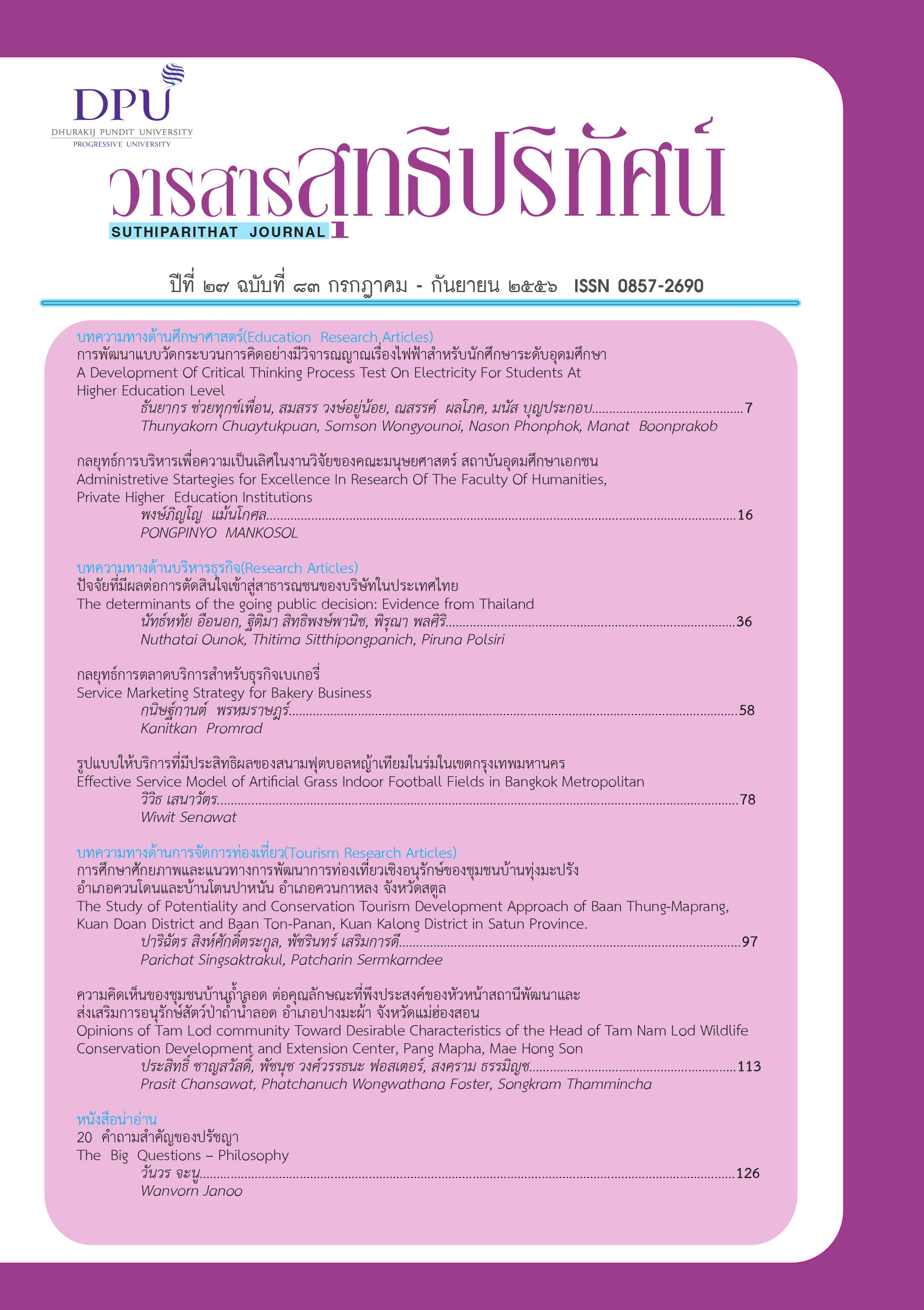ปัจจัยที่มีผลต่อการตัดสินใจเข้าสู่สาธารณชนของบริษัทในประเทศไทย
คำสำคัญ:
การเข้าสู่สาธารณชน, กลุ่มธุรกิจ, ประเทศไทยบทคัดย่อ
การวิจัยนี้มีวัตถุประสงค์เพื่อศึกษาปัจจัยที่มีผลต่อการตัดสินใจเข้าสู่สาธารณชนของบริษัทในประเทศไทย ตัวอย่างที่ใช้ในการศึกษามีจำนวน 1,210 บริษัท โดยใช้ข้อมูลระหว่างปี 2543-2548 การวิเคราะห์ข้อมูลใช้แบบจำลองโพรบิท ซึ่งได้นำตัวแปรกลุ่มธุรกิจเข้าไปรวมไว้ในแบบจำลองครั้งนี้ด้วย เนื่องจากกลุ่มธุรกิจมีความสำคัญในประเทศกำลังพัฒนา โดยเป็นเสมือนตลาดทุนภายในให้กับสมาชิกของกลุ่มธุรกิจในการโยกย้ายเงินทุนภายในกลุ่มให้กับสมาชิกที่ไม่สามารถเข้าถึงแหล่งเงินทุนภายนอกได้เพื่อลดปัญหา ความไม่สมมาตรของข้อมูลและความไม่สมบูรณ์ของตลาดทุน แต่อย่างไรก็ตาม กลุ่มธุรกิจอาจก่อให้เกิดความไม่มีประสิทธิภาพในการโยกย้ายทรัพยากรระหว่างสมาชิกในกลุ่ม และการลงทุนที่ไม่เหมาะสมในกลุ่มธุรกิจ รวมทั้งปัญหาตัวแทนระหว่างผู้ถือหุ้นรายใหญ่และผู้ถือหุ้นรายย่อยของบริษัทจดทะเบียนในกลุ่มธุรกิจ ผลการวิจัยพบว่าบริษัทที่เป็นสมาชิก กลุ่มธุรกิจจะเลือกเข้าสู่สาธารณชนมากกว่าบริษัทที่ไม่ได้เป็นสมาชิกของกลุ่มธุรกิจ ซึ่งอาจแสดงให้เห็นว่าบริษัทจะได้ประโยชน์จากการนำเงินที่ได้จากผู้ถือหุ้นรายอื่นมาจัดสรรให้กับสมาชิกภายในกลุ่ม นอกจากนี้ผลการวิจัยแสดงให้เห็นว่าบริษัทที่มีขนาดใหญ่มีปัญหา ความไม่สมมาตรของข้อมูลน้อยกว่าบริษัทที่มีขนาดเล็ก จึงทำให้มีความเป็นไปได้ที่จะเข้าสู่สาธารณชนมากกว่า อย่างไรก็ตามผู้วิจัยพบว่าปัจจัยด้านอายุ และความสามารถในการทำกำไรของบริษัท มีผลทำให้ความน่าจะเป็นที่บริษัทจะเข้าสู่สาธารณชนน้อยลง กล่าวคือ บริษัทที่มีอายุน้อยมีปัญหา Adverse selection ทำให้มีข้อจำกัดในการเข้าสู่แหล่งเงินทุนภายนอกอื่นๆ สำหรับบริษัทมีความสามารถในการทำกำไรสูงมีความเป็นไปได้ที่จะไม่เข้าสู่สาธารณชนสอดคล้องกับทฤษฎีลำดับขั้น เพราะบริษัทมีแหล่งเงินทุนภายในที่มาจากกำไรสะสมสูง การศึกษาครั้งนี้มีข้อเสนอแนะดังนี้ ประการแรกการที่บริษัทในกลุ่มธุรกิจมี ความเป็นไปได้ในการเข้าสู่สาธารณชนสูงเป็นประโยชน์ต่อการพัฒนาตลาดทุน แต่อย่างไรก็ตาม ตลาดทุนควรมีกลไกในการป้องกันปัญหาที่อาจเกิดขึ้นจากการที่บริษัทเอาเปรียบ ผู้ลงทุนรายย่อยในการถ่ายโอนทรัพยากรจากบริษัทจดทะเบียนไปยังบริษัทอื่นในกลุ่มธุรกิจ ประการที่สองตลาดทุนควรส่งเสริมให้บริษัทที่มีอายุมากเข้าสู่สาธารณชนมากขึ้นเนื่องจาก บริษัทที่ก่อตั้งมานานมักมีชื่อเสียงและความน่าเชื่อถือสูง อาจจะทำให้เป็นที่สนใจของนักลงทุนในตลาดทุนมากขึ้น ประการสุดท้าย สถาบันการเงินที่เกี่ยวข้องควรเปิดโอกาสในการเข้าถึงแหล่งเงินทุนภายนอกสำหรับบริษัทอายุน้อยให้มากขึ้นเพื่อสนับสนุนการเติบโตของบริษัท ซึ่งจะส่งผลดีต่อการพัฒนาเศรษฐกิจของประเทศต่อไป
เอกสารอ้างอิง
สุมาลี อุณหะนันทน์. (2550). การบริหารการเงิน. พิมพ์ครั้งที่ 6. กรุงเทพมหานคร: สำนักพิมพ์จุฬาลงกรณ์มหาวิทยาลัย
Albornoz, B. G. and Pope, P. F. (2004). The determinants of the going public decision: evidence from the U.K. Working paper.
Aslan, Hadiye, and Praveen Kumar. (2007). Going Public and Going Private: What Determines the Choice of Ownership Structure?, Working paper.
Bancel, F., and U. R. Mittoo. (2008). Why European firms go public?. Working paper.
Belenzon, S., and Berkovitz, T. (2008). Business Group Affiliation, Financial Development and Market Structure: Evidence from Europe. Working paper.
Bhattacharyam, S., and Ritter, J.R. (1983). Innovation and Communication: Signaling with Partial Disclosure. Review of Economic Studies, 50, 331-346.
Brau, James, Bill Francis, and Ninon Kohers. (2003). The Choice of IPO versus Takeover: Empirical Evidence. Journal of Business, 76, 583-612.
Brau, J., Lambson, V.E., and McQueen, G. (2005). Lockups Revisited. Journal of financial and quantitative analysis, 2005, 40 (3), 519-530.
Brau, J. C., and Fawcett, S.E. (2006). Initial Public Offerings: An Analysis of Theory and Practice. Journal of Finance, LXI (1), 399-436.
Campbell, Tim. (1979). Optimal Investment Financing Decisions and the Value of Confidentiality. Journal of Financial and Qualitative Analysis, 14, 913-924.
Chemmanur, Thomas, and Paolo Fulghieri. (1999). A Theory of the Going-Public Decision. Review of Financial Studies, 12 (2), 249-279.
Chemmanur, T. J., S. He and D. Nandy. (2005). The going-public decision and the product market, Working paper, Boston College.
Claessens, S., Fan, J. P. H., and Lang, L. H.P. (2002). The Benefits and Costs of Group Affiliation: Evidence from East Asia. Working paper.
Ferris, S. P., Kim, K. A., and Kitsabunnarat, P. (2003). The costs (and benefits?) of diversified business groups: The case of Korean chaebols. Journal of Banking & Finance, 27, 251-273.
Fischer, C. (2000). Why Do Companies Go Public? Empirical Evidence from Germany’s Neuer Markt. Working paper.
George, R., and Kabir, R. (2008). Business groups and profit redistribution: A boon or bane for firms?. Journal of Business Research, 61, 1004-1014.
Gleason, K., Payne B., and Wiggenhorn J. (2007). An Empirical investigation of going private decisions of U.S. Firms. Journal of Economics and Finance, 31, 207-218.
Gopalan, R., Nanda, V., and Seru, A. (2007). Affiliated firms and financial support: Evidence from Indian business groups. Journal of Financial Economics, 86, 759-795.
Huyghebaert, N. and C.V. Hulle. (2005). Structuring the IPO: Empirical evidence on the portions of primary and secondary shares. Journal of Corporate Finance, 12 (2), 296-320.
Khanna, T. and Palepu, K. (2000). Is Group Affiliation Profitable in Emerging Markets? An Analysis of Diversified Indian Business Groups. Journal of Finance, LV (2), 867-891
Khanna, Tarun, and Yishay Yafeh. (2005). Business Groups and Risk Sharing Around the World. Journal of Business, 78, no. 1, 301-340.
Kim, W., and M. S. Weisbach. (2005). Do firms go public to raise capital?. NBER Working paper, February.
Kim, Jeong-Bon., and Yi, Cheong H. (2005). Ownership Structure, Business Group Affiliation, Listing Status, and Earnings Management: Evidence from Korea. Working paper.
Maksimovic, V. and P. Pichler. (2001). Technological innovation and initial public offerings. Review of Financial Studies, 14, 459-494.
Mayur, M., and Kumar, M. (2006). An Empirical Investigation of Going Public Decision of Indian Companies. Working paper.
Myers, S. C. (1984). The capital structure puzzle. Journal of Finance, 39, 575-592.
Myers, S. C., and N. S. Majluf. (1984). Corporate financing and investment decisions when firms have information
that investors do not have. Journal of Financial Economics, 13, 187-221.
Pagano, M., F. Panetta, and L. Zingales. (1998). Why Do Companies Go Public? An Empirical Analysis. Journal of Finance, 53 (1), 27-64.
Pannemans, S. (2002).Going Public: Opportunism or Necessity? Empirical Evidence from Belgian IPOs. Working paper.
Polsiri, P., and Wiwattanakantang, Y., (2004). Business Groups in Thailand: Before and after the East Asian Financial Crisis. Center for Economic Institutions. Working paper series, vol. 13, 1-43.
Rajan, R., and L. Zingales. (1998). Financial Dependence and Growth. American Economic Review, 88, 559-586.
Ritter, J. R. (1987). The Costs of Going Public. Journal of Financial Economics, 19 (2), 269-281.
Ritter, J. R. (1991). The Long-Run Performance of Initial Public Offerings. Journal of Finance, 46, 3-27.
Ritter, J. R., and I. Welch. (2002). A Review of IPO Activity, Pricing, and Allocations. Journal of Finance, 57 (4), 1795-1828. Rosen, R.J., Smart, S. B., and Zutter, C.J. (2005). Why Do Firms Go
Public? Evidence from the Banking Industry. Working paper. Welch, Ivo. (1989). Seasoned offerings, imitation costs, and the underpricing of initial public offerings. Journal of Finance, 44, 421-449.
Shen, Yang-Pin, and Wei. P. (2007). Why do companies choose to go IPOs? New results using data from Taiwan. Journal of Economics and Finance, 31 (3), 359-367.
Yosha, Oved. (1995). Information disclosure costs and the choice of financing source. Journal of Financial Intermediation, 4, 3-20.
ตลาดหลักทรัพย์แห่งประเทศไทย. (2552). แผนพัฒนาตลาดทุนไทย. ค้นเมื่อ 15 ธันวาคม 2552, จาก http://www.sec.or.th/sec/ppt_CMP_Master.pdf
ตลาดหลักทรัพย์แห่งประเทศไทย. (2551). ข้อมูลการเข้าจดทะเบียน. ค้นเมื่อ 21 พฤศจิกายน 2551, จาก http://www.set.or.th/
th/products/listing/info_p1.htmlhttp://www.set.or.th/th/products/listing/info_p1.html
สำนักงานคณะกรรมการกำกับหลักทรัพย์และตลาดหลักทรัพย์. (2551). การออกและเสนอขายหลักทรัพย์. ค้นเมื่อ 15 กุมภาพันธ์ 2551, จากhttp://www.sec.or.th/securities_issuance/Content_0000000007.jsp?categoryID=CAT0000066&lang=th
Word Federation of Exchanges. (2011). WFE Annual report and statistics. Retrieved May 8, 2012, from http://www.world-exchanges.org/files/statistics/excel/WFE11%20final.pdf
ดาวน์โหลด
เผยแพร่แล้ว
รูปแบบการอ้างอิง
ฉบับ
ประเภทบทความ
สัญญาอนุญาต
เนื้อหาและข้อมูลในบทความที่ลงตีพิมพ์ในวารสารสุทธิปริทัศน์ ถือเป็นข้อคิดเห็นและความรับผิดชอบของผู้เขียนบทความโดยตรงซึ่งกองบรรณาธิการวารสาร ไม่จำเป็นต้องเห็นด้วย หรือร่วมรับผิดชอบใด ๆ
บทความ ข้อมูล เนื้อหา รูปภาพ ฯลฯ ที่ได้รับการตีพิมพ์ในวารสารสุทธิปริทัศน์ ถือเป็นลิขสิทธิ์ของวารสารสุทธิปริทัศน์หากบุคคลหรือหน่วยงานใดต้องการนำทั้งหมดหรือส่วนหนึ่งส่วนใดไปเผยแพร่ต่อหรือเพื่อกระทำการใด ๆ จะต้องได้รับอนุญาตเป็นลายลักษณ์อักษรจากวารสารสุทธิปริทัศน์ก่อนเท่านั้น







